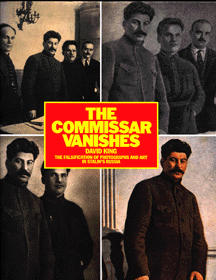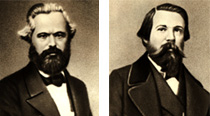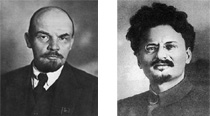The article below may be copied and circulated but proper attribution of authorship is required.
A pictorial history of Stalinist falsification.
By F. Kreisel, November 10, 1997
 |
The recent publication of David King's "The Commissar Vanishes" is an important event in Soviet historiography. This collection of photographs, posters and paintings clearly illustrates that the Stalinist regime was based on an enormous lie. Richard Lourie correctly writes in his review of the book, "Of all the lies those images were to perpetuate, two were paramount: Stalin was close to Lenin and there was no such person as Trotsky" ("The New York Times Book Review, Nov. 9, 1997). The opposite is the case. Firstly, Stalin's policy of national "socialism" represented a negation of Lenin's policy of international socialist revolution and eventually led to the overthrow of all the gains of the October Revolution. Secondly, Trotsky and the Left Opposition represented the real alternative to the totalitarian bureaucracy and stood for the true development of Marxism. |
David King is well placed to assemble this book. A former arts editor of the Sunday Times magazine, for thirty years he has been collecting pictorial documents related to the history of the Soviet Union. In 1972 he and David Wyndham published a wonderful illustrated documentary of Leon Trotsky. This new pictorial history illustrates the extent of the political genocide which Stalin committed in the Soviet Union and even beyond its borders.
The physical extermination of the bearers of socialist culture in Russia began with attacks on the most conscious and vocal representatives of revolutionary Marxism, the Oppositionists grouped around Trotsky. However, in the process of consolidating itself into a privileged ruling elite, the Stalin faction had to constantly extend the circle of its enemies. Political repression by stages enveloped all the mature layers of the Bolshevik Party, the comrades of Lenin who led the Revolution and built the Soviet state. It extended to all those who witnessed the Revolution, the socialist minded intellectuals outside the Party, the supporters of other socialist groupings, former Mensheviks and SRs inside the Soviet Union. Eventually the reactionary bureaucracy found itself at odds with the main human basis of the Soviet regime: the officers of the Red Army, the technical and cultural elite, all the top and middle layers of the Party and so on. Stalin's secret police spread even outside the borders of the Soviet Union and GPU prisons and killing cellars were set up in Republican Spain to murder Anarchists, POUMists and other independent revolutionists. This campaign of exterminating Marxist consciousness culminated in 1940 with the murder in Mexico of Leon Trotsky by one of Stalin's hired killers.
Unfortunately, the book's truth telling value is undermined somewhat by the anticommunist prejudices of its writers and reviewers. In the book's Preface, Stephen F. Cohen omits any mention of Trotsky, Stalin's main reason for all the historical falsification. Instead Cohen tries to resurrect the myth of Bukharin as a democratic and reformist alternative to Stalin. This was Cohen's main politico-historical line both in his biography of Bukharin and in his many publications over the last decade in Russia and in the West.
In the Preface to the book Cohen describes his horror at seeing how the widow of a Bolshevik leader murdered by Stalin was forced to deface his memory in the family photo album. This sentiment would be laudable, were it not for the fact that Cohen borrows it (without attribution) from Trotsky.
Commenting on the memoirs which were coming out in the second half of the 1930's, Trotsky wrote that the widow of S. Spandarian, who was in exile with Stalin in Turukhansk prior to the Revolution,
"is being forced, and one cannot express it otherwise, to rob her former husband's memory in favor of Stalin's historical reputation (Trotsky had in mind the article by V. Schweitzer, "Comrade Stalin in exile in Turukhansk" in "Proletarskaia revolutsiia", 1937, #8, pp. 161-164). A similar sort of pressure was applied many times to Krupskaya. She went far in her submission. Still, Krupskaya proved to be made of a sterner mettle, and it is much harder to rob Lenin's memory. These attacks by the historians on the widows with the aim of robbing their former husbands so as to fill out the blank spots in Stalin's biography seem completely unforgivable. Nothing in world history compares to this in maliciousness and a systematic, merciless cynicism" ("Stalin", Moscow, vol. 2, p. 154).
Another reviewer of this book, Quentin Peel of the London Financial Times, also omits any mention of Trotsky and instead concentrates on the virtually unknown and politically unimportant Avel Yenukidze (Financial Times, November 1, 1997). Reviews and comments like the ones by Peel and Cohen seek to perpetuate Stalin's efforts to rub Trotsky out of history. Trotsky once wrote that the forces of history are stronger than even the omnipotent General Secretary. We think that historical truth will also vanquish its contemporary falsifiers like Cohen and Peel.




